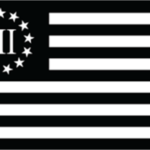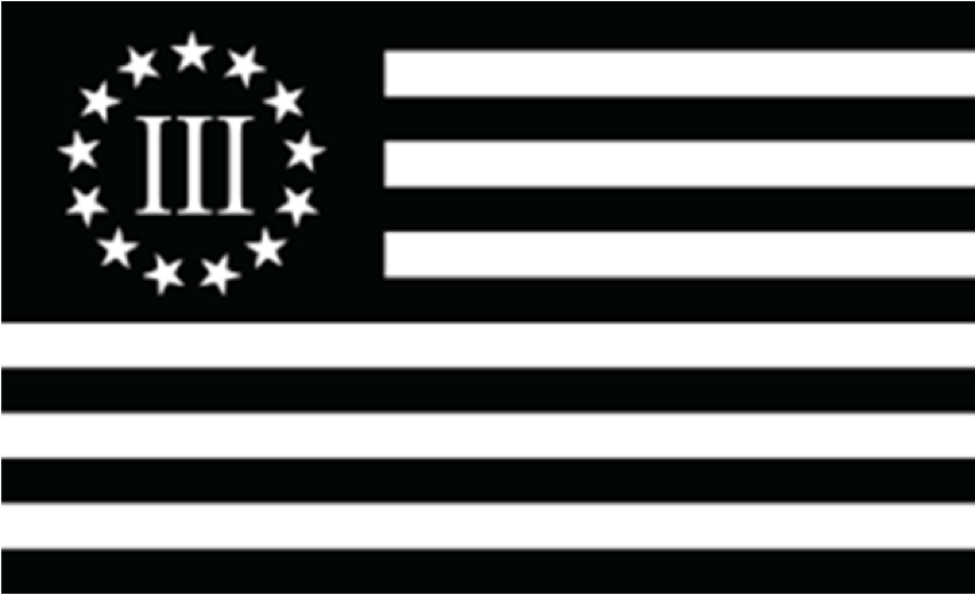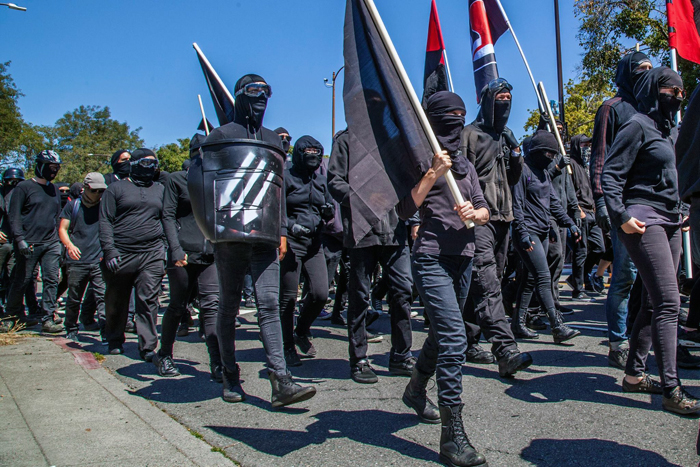America’s Modern Civilian Militias
Written by: Samuel Lisanti
A
rising number of civilian militias in the United States represents a growing belief among those on the far right that organized preparation for armed conflict is a necessary precaution, whether against outside invasion or government tyranny. Today’s advanced military technology may make the concept of a civilian militia seem antiquated, but private, civilian militias are quite prevalent in the United States today. Indeed, their numbers have increased by more than 500 percent over the last decade, and their presence at flash-points of civil unrest has ramped up noticeably.
While the vast majority of citizen militias fall under the broad umbrella of the far-right wing, beliefs and motives vary widely from between groups. Many militia members practice and prepare to counter a tyrannical government. Government seizure of privately-owned firearms is frequently cited as the ‘red line’ that would trigger a militia to armed resistance. Other groups cite the potential imposition of martial law as a reason for why militias must remain prepared.1 Preparation for a foreign invasion, particularly from Russia or North Korea, is also a recurring justification for militia involvement.2
The ‘prevention-of-tyranny’ justification is often supported through an interpretation of the U.S. Constitution’s Second Amendment, which says, “A well regulated Militia, being necessary to the security of a free State, the right of the people to keep and bear Arms, shall not be infringed.” Militia members argue that this first clause – “A well regulated Militia, being necessary to the security of a free State,” affirms the need for civilian militias. Groups such as the Washington State Militia believe the maintenance of such a militia is meant to prevent the rise of government tyranny.3 Volunteers see themselves as the last defense against the rise of a totalitarian regime.
Many militia members also seek to defend their families from violence. Lightfoot Militia, a confederation of militias across the United States, states on its website that defense of family from evil is a primary reason for enlisting in their militia.4 The 1994 Los Angeles race riots exemplify the kind of threat many militia members believe could rapidly engulf them.1 Others merely seek a return to a simpler and safer time. Robert Mitchell, commander of the Citizens Militia of Mississippi, reflected in 2014 that he and his compatriots sought to provide their communities with the same sense of security they had when they were children.5
In addition to motivation, militia groups are highly diverse in their views on race and religion. While some groups are driven by a belief in white supremacy, others pointedly reject such a title.6 The same applies to the topic of religion. Some militia members have conducted surveillance of mosques or even dis- cussed killing Muslims.7 Others, such as the leader of the Southern Arizona Militia, a man known only as “Silverback,” have allowed individuals of other religions to join the militias.8 The Lightfoot Militia proclaims on its website that it does not “espouse any particular religious denominations or doctrine.”4
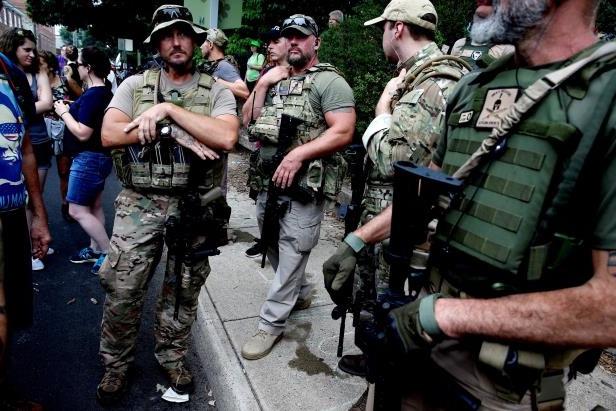
Militia members in Charlottesville, VA © Joshua Roberts/Reuters
Militias tend to be well-armed and prepared for battle. According to Virginia Governor Terry McAuliffe, the militias present in Charlottesville for the August 2017 ‘Unite the Right’ rally had better equipment than the state police.9 Johnny Cochran, a U.S. Marine Corps veteran and leader of Fireteam Diamondback, a Texas militia, demonstrates how well-armed many militia members are. He carries an AR15 semi-automatic rifle, two knives, a shotgun, and a pistol in his car alone.1 Groups such as the Ohio Defense Force boast a mixture of hunting rifles, semi-automatic carbines, and an M-60 machine gun.6 Organized groups often implement a paramilitary command structure.6 Militias often train in rural and woodland areas, emphasizing hand-to-hand combat and weapons handling.1
The number of militia groups has sharply increased in the past decade. The Southern Poverty Law Center reported there were 276 active militia groups in America in 2015, up from 202 in 2014 and a mere 42 in 2008.10 The rapid growth of these groups has raised concerns among law enforcement at both the state and national level. Authorities fear a flare-up of violence similar to the wave of right-wing violence in the 1990s that centered on the sieges of Ruby Ridge, Idaho, and Waco, Texas.6
Lately, militias have reentered the public knowledge through appearances at riots and protests across the country. In 2015, race riots in Ferguson, Missouri drew out the Oathkeepers, a militia founded to “defend the Constitution against all enemies, foreign and domestic.” Members of the group patrolled the streets, brandishing semi-automatic rifles. The group did not adopt an official stance on the fighting, claiming it was present to protect the rights of protesters.11
The August 2017 right-wing rally in Charlottesville saw a full-scale deployment of militia members. Volunteers wielding semi-automatic carbines and wearing camouflage were a familiar and imposing sight. The groups hailed not only from Virginia but from New York, Pennsylvania, and several other states. Like the Oathkeepers in Ferguson, the militia members did not take sides in the fighting but sought to keep the peace between opposing sides.12 Christian Yingling, leader of the Pennsylvania Light Foot Militia, said “Our mission was to help people exercise their First Amendment rights without being physically assaulted.” The members did not take part in the fighting.13
Two other significant events have shed light on the rise of civilian militias. The first is that of the 2014 standoff between the Bundys, a ranching family in Nevada, and the Bureau of Land Management (BLM). For years, the Bundys had grazed their cattle on federally-owned land without paying grazing fees, as they believed the federal government did not have the right to control the land. BLM employees attempted to round up the Bundys’ cattle but withdrew after hundreds of militia members and supporters, some of whom were armed, opposed them. A judge later dismissed charges against Cliven Bundy, the family father, and his sons, declaring that the government had withheld evidence.14
Emboldened by their successful deterrence of the federal government, Ammon Bundy, Cliven’s son, led a group of militia members in occupying a federal facility in Oregon. Federal ownership of land was again front and center. In 2012, Dwight Hammond, Jr. and his son Steven were sentenced to jail for starting controlled fires on federal land adjacent to their property.15 In mid-December of 2015, the pair faced re-imprisonment.16 In response, Ammon Bundy and his militia, Citizens for Constitutional Freedom, took over the headquarters of Malheur National Wildlife Refuge on January 2, 2016.17
The occupation lasted for 41 days before federal officials arrested the last of the group. By the end of the standoff, of the original 16 militia members, only four were left; the others had been arrested.16 One of the occupiers died after he attempted to run a police blockade and was shot while reaching for his jacket pocket.18 In a surprising turn of events, a jury found seven defendants not guilty of charges of “conspiring to impede federal employees from doing their job.”19
The election of Donald Trump has caused a shift in the approach of the militia movement. Now that a more ideologically agreeable president has taken office, many militia members feel less threatened by the possibility of a government takeover. Indeed, the change in administrations has had a significant impact on militia numbers. The Southern Poverty Law Center reported that the number of active militias dropped from 276 in 2015 to 165 in 2016, a 40% decrease.20 Many of those remaining in the movement have shifted their sights from the government to the Antifa (anti-fascist) movement.12
Perhaps the most important element surrounding the militia movement is their legal standing. In both the Nevada standoff and the Malheur occupation, militia members that threatened and obstructed federal employees went free. This is a concerning precedent with potentially lethal consequences should another militia group challenge law enforcement. Until now, militias have largely been allowed to operate with impunity. While militias are normally peaceful and well-intentioned, as in Charlottesville, the ominous presence of armed, non-state actors in often heated situations is a trend that begs to be addressed. Preparation for future encounters with self-proclaimed militias should involve cooperation and collaboration of local, state, and federal officials. Thus far, with a few tragic exceptions, violence has largely been avoided, due to cooler heads prevailing. However, the government cannot count on this trend to continue.
Militias present in Charlottesville for the August 2017 ‘Unite the Right’ rally had better equipment than the state police.
Authorities should outline clear protocols and procedures for dealing with civilian militias before the next major confrontation. These preparations should focus largely on instituting a better legal framework for regulating and responding to militia activity. Congress should craft and pass a law preventing militias from operating in a military capacity.21 Such a law should allow training, as this is a protected Second Amendment exercise, but should focus on public attempts to act like law enforcement or the military. This would prevent militia groups from attempting to intervene in situations such as Charlottesville and eliminate many of the immediate situations that could lead to bloodshed.
Until now, officials have generally refrained from restraining militia groups in situations such as the Malheur occupation unless a group poses an imminent threat.22 However, allowing militia members to patrol and operate in public with the potential use of force is too dangerous to allow. The use or threat of force is meant to be strictly limited to the government. Preventing militia groups from attempting to use force would preserve these limitations and ensure that if force must be used, it lies with the government, not unaccountable and unelected groups. Enforcement of this law must be carried out carefully and judiciously, as emotions could easily boil over and lead to violence. Inaction, however, is a more worrisome choice that could result in a growing belief among militia members that they are above the law. ■
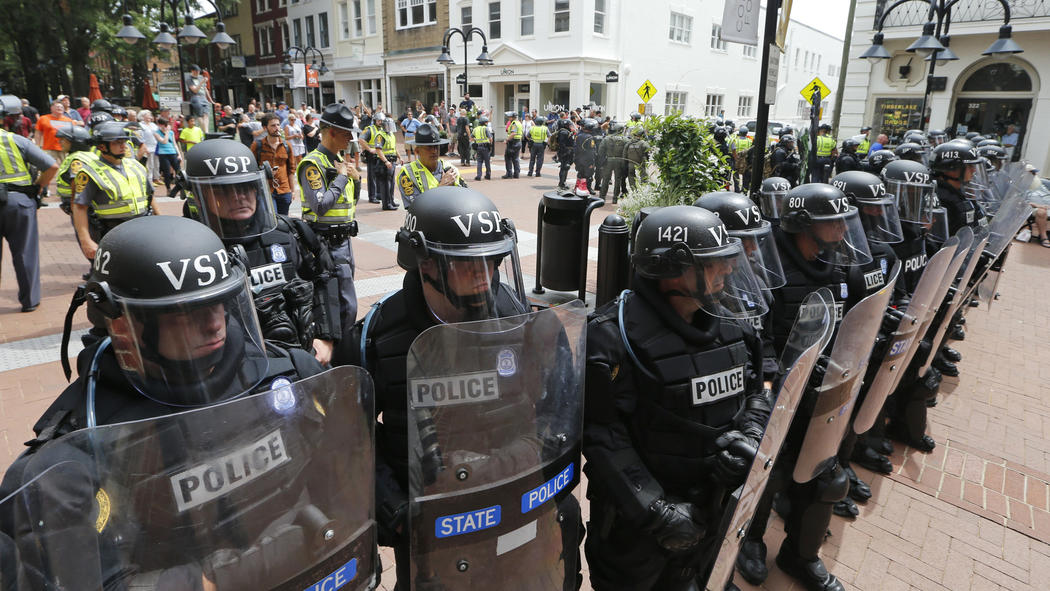
Riot police in Charlottesville, VA © Chicago Tribune


